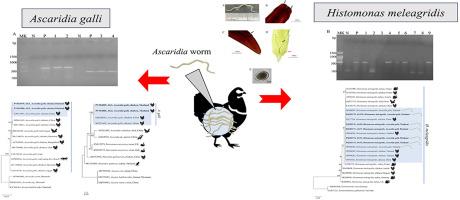Molecular evidence of Histomonas meleagridis in Ascaridia galli from chickens in Thailand: Possibility of transmission pathways
IF 2.5
3区 医学
Q2 PARASITOLOGY
引用次数: 0
Abstract
The poultry industry in Thailand plays a vital role in national food security and economic stability. Ascaridia galli is among the most prevalent and pathogenic nematodes affecting chickens, contributing to significant losses in global poultry production. Histomoniasis, another serious disease, causes severe liver and caecal lesions and high morbidity. Despite the importance of both parasites, the information of the molecular characterization of A. galli and the detection of Histomonas meleagridis within adult A. galli in Thailand is still limited. In this study, cytochrome c oxidase subunit 1 (COI) and 12S ribosomal RNA (12S rRNA) genes were amplified by polymerase chain reaction (PCR) from 20 adult Ascaridia nematodes. Additionally, 18S ribosomal RNA (18S rRNA) gene amplification was performed to confirm H. meleagridis infection. The resulting sequences were aligned and compared with reference sequences of A. galli, H. meleagridis, and other related protozoa. Both COI and 12S rRNA sequences confirmed the identity of the nematodes as A. galli. Notably, H. meleagridis DNA was detected exclusively in female A. galli specimens. These findings suggest that female A. galli may act as a potential reservoir host in the transmission cycle of H. meleagridis in chickens. This study represents the molecular evidence of H. meleagridis DNA within A. galli collected from the intestinal contents of deceased chickens clinically suspected of histomoniasis.

泰国鸡源加利利蛔虫中肉麻组织单胞菌的分子证据:传播途径的可能性
泰国的家禽业对国家粮食安全和经济稳定起着至关重要的作用。加利蛔虫是影响鸡的最普遍和致病性最强的线虫之一,对全球家禽生产造成重大损失。另一种严重的疾病是组织癣,它会导致严重的肝脏和盲肠病变,发病率很高。尽管这两种寄生虫都很重要,但在泰国,关于加利利单胞菌的分子特征和在成年加利利单胞菌中检测到meleagridis的信息仍然有限。本研究用聚合酶链反应(PCR)扩增了20只成虫的细胞色素c氧化酶亚基1 (COI)和12S核糖体RNA (12S rRNA)基因。此外,通过18S核糖体RNA (18S rRNA)基因扩增,证实了肉苁苁菌的感染。将所得到的序列与参考序列进行比对,并与甲状螺旋体、肉芽孢杆菌和其他相关原生动物进行比较。COI和12S rRNA序列均证实了该线虫的身份。值得注意的是,在雌性galli标本中仅检测到meleagridis DNA。这些结果提示,在肉苁苁菌在鸡体内的传播周期中,雌性加利利拟虫可能是潜在的宿主。本研究代表了从临床怀疑患有组织血吸虫病的死鸡的肠道内容物中采集的甲状芽孢杆菌中存在肉芽孢杆菌DNA的分子证据。
本文章由计算机程序翻译,如有差异,请以英文原文为准。
求助全文
约1分钟内获得全文
求助全文
来源期刊

Acta tropica
医学-寄生虫学
CiteScore
5.40
自引率
11.10%
发文量
383
审稿时长
37 days
期刊介绍:
Acta Tropica, is an international journal on infectious diseases that covers public health sciences and biomedical research with particular emphasis on topics relevant to human and animal health in the tropics and the subtropics.
 求助内容:
求助内容: 应助结果提醒方式:
应助结果提醒方式:


